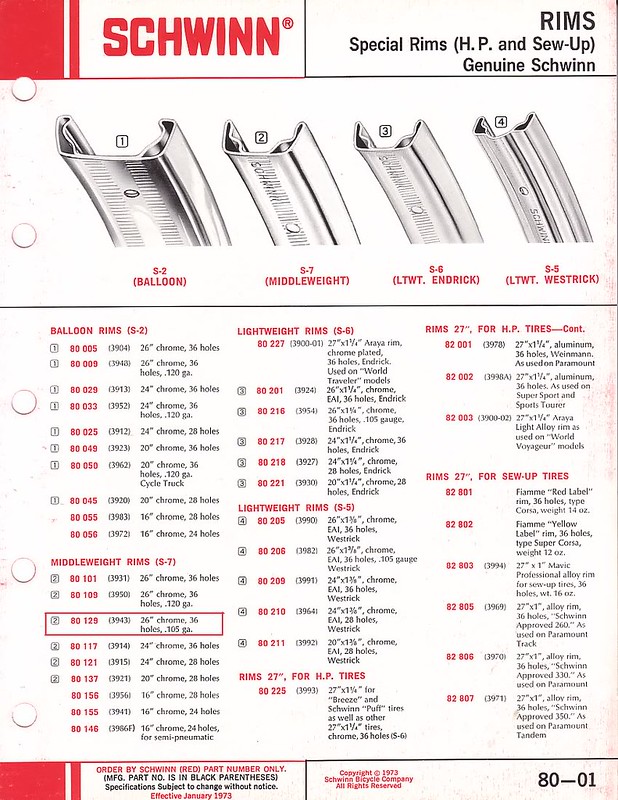Originally posted in a Swap Meet thread by Iven. I moved it here as a better place for the discussion. Please feel free to join in with all Schwinn tire sizing questions regarding S-2 balloon tires, S-7 middleweight tires, S-5/S-6 lightweight tires, as well as dimensional tire information.
==================================
Re: Vintage Schwinn Rim Set
New post by iven on Thu Jan 31, 2013 1:37 am
i dont mean to * in your thread or anything but i need to rant about something related..
so i rode my 5spd schwinn stingray over to an LBS and asked about tires 'the front is almost gone, the back already blew out' anyway..
i grabbed a 20x1.75 tire and asked if it would fit the schwinn S7 rim and if 'since the tire is a Repo maybe it has a Larger bead like the S2 tires do.
and
then the owner of the shop asked me in a snide voice 'whats the difference in 20x1.75 and 20x1 3/4' and thinking mathamatically yes 1.75' = 1.3/4'
as far as i know, but he said 'well Not when it comes to Tires'
so ok i know they are a difference in size when it comes to inch/mm in tires but still. then he started to rant on about how i need the S2 tire..
ok i get that, then hes like Nagging on me then about 'i have been in this buissness for a long time and i know what im talking about' blah blah.
like ok, i wasnt questioning if he was correct about what tires i need or what, i was trying to ask if i need an S2 tire what does it mean that my rims are Stamped S7 ????
But NO He got even more Snotty with me and was tellin me off about how "There Is No Such Thing As An S7"
uhm.. well why are my rims Stamped S7 then?
thats all i wanted to know, but no he had to go and try to tell me off or something cause he couldnt understand i was asking what my Rims are..
god, sometimes being young sucks, people don't take you serously when it comes to building things. its a realll Kickkk in the side.
i dont go to bike shops cause i need to buy their marked up parts, i go cause they have something i can get now and 'some' of the people are nice to talk to, man needless to say i wont be heading back to that store..
that guy is straight up disrespectful.
so i ask here, whats up with S2 - S7 wheel/tires :roll:
==================================
Re: Vintage Schwinn Rim Set
New post by iven on Thu Jan 31, 2013 1:37 am
i dont mean to * in your thread or anything but i need to rant about something related..
so i rode my 5spd schwinn stingray over to an LBS and asked about tires 'the front is almost gone, the back already blew out' anyway..
i grabbed a 20x1.75 tire and asked if it would fit the schwinn S7 rim and if 'since the tire is a Repo maybe it has a Larger bead like the S2 tires do.
and
then the owner of the shop asked me in a snide voice 'whats the difference in 20x1.75 and 20x1 3/4' and thinking mathamatically yes 1.75' = 1.3/4'
as far as i know, but he said 'well Not when it comes to Tires'
so ok i know they are a difference in size when it comes to inch/mm in tires but still. then he started to rant on about how i need the S2 tire..
ok i get that, then hes like Nagging on me then about 'i have been in this buissness for a long time and i know what im talking about' blah blah.
like ok, i wasnt questioning if he was correct about what tires i need or what, i was trying to ask if i need an S2 tire what does it mean that my rims are Stamped S7 ????
But NO He got even more Snotty with me and was tellin me off about how "There Is No Such Thing As An S7"
uhm.. well why are my rims Stamped S7 then?
thats all i wanted to know, but no he had to go and try to tell me off or something cause he couldnt understand i was asking what my Rims are..
god, sometimes being young sucks, people don't take you serously when it comes to building things. its a realll Kickkk in the side.
i dont go to bike shops cause i need to buy their marked up parts, i go cause they have something i can get now and 'some' of the people are nice to talk to, man needless to say i wont be heading back to that store..
that guy is straight up disrespectful.
so i ask here, whats up with S2 - S7 wheel/tires :roll:











































